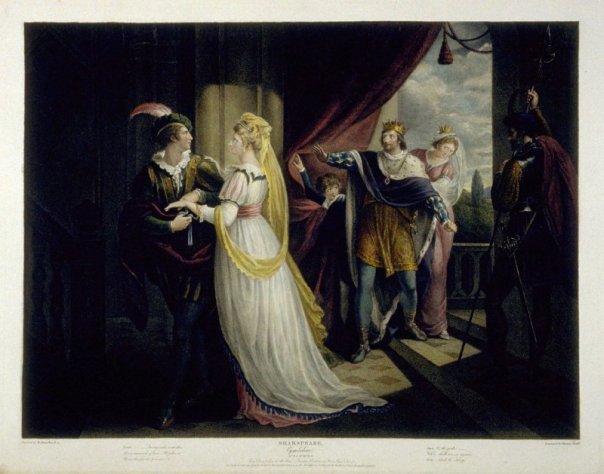Cymbeline Plot Analysis
By: Armyn De Guia
 Shakespeare: Cymbeline, Act I, Scene II
Shakespeare: Cymbeline, Act I, Scene II
William Shakespeare’s Cymbeline is a play that appeared in the First Folio under tragedy. However, critics often argue that this play is a romance or a comedy. Cymbeline is a play that features themes such as love, patriotism, social class, deceit, faithfulness, and mistaken identity.
The play starts off with two gentlemen giving a brief history of several characters. The King Cymbeline, has a daughter, Imogen, and had to other sons who were stolen away from him when they were babies. Posthumus Leonatus, had lost both his parents when he was a child in which Cymbeline took him in and took care of him. After the gentlemen end their monologues, the play then starts off with the banishment of Posthumus Leonatus because Cymbeline has found out that Imogen has married Posthumus. Posthumus is banished and goes to Italy where his friends are at and this is where he starts a bet with Iachimo about Imogen’s faithfulness. Back in Britain the Queen is trying to make her son Cloten the new King and trying to marry Imogen to him. Since Imogen is not swayed the Queen tries to poison Pisanio, Posthumus’s servant, so that her last tie with Posthumus is gone. However, the poison is only a sleeping potion and Pisanio gives it to Imogen believing it is a sleeping drug. Back in Rome, Iachimo gives Posthumus a fake letter and his bracelet to make Posthumus believe his wife has been unfaithful to him and because of this he plans to kill her.
Imogen then leaves Cymbeline’s place disguised as boy named Fidel. When she leaves she ends up in a cave where she finds her long lost brothers. Cloten, also disguises himself as Posthumus to win Imogen over. He is later killed by one of the brothers. Imogen is also thought to be dead and so is Posthumus. The two end up find each other again during the war between Britain and Rome. At the end of the play, the Cymbeline pardons Rome for paying the tax and is reunited with his sons. The Queen dies but confesses all that she has done and Posthumus and Imogen are reunited again. Everything ends happily.
In our adaptation, our group decided to focus on the romance between Imogen and Posthumus. We felt that one of the important scenes in the play was Posthumus’ banishment. Imogen and Posthumus’ love represents those who cannot be together because it is seen as unacceptable by other people. The setting of our play takes place during the aids epidemic where people were fearing people who were homosexual. Since Imogen and Posthumus’ relationship was not accepted in the play, the aids epidemic and fear of homosexuality allowed for that kinds of tension between the Imogen’s family and Posthumus. Our adaptation also showed how Cymbeline features strong women. Both Imogen and the Queen had a lot of power in the novel. Not only that but their actions were their own choices. Imogen was not swayed by the temptations of Cloten and Iachimo and remained faithful to Posthumus. Imogen is smart and stands up to both Cymbeline and the Queen. She acts based on what she wants and no one else’s. The Queen is seen a very cunning in the play. She devised plans just so Cloten can become King. Similarly to Imogen, her actions and thoughts are her own. Our radical adaptation emphasizes the romance between Imogen and Posthumus and the strong portrayal of women in Cymbeline.
Work Cited
Burke, Thomas. Shakespeare: Cymbeline, Act I, Scene II. Digital image. De Young L Legion of Honor. Fine Arts Museum of San Francisco, n.d. Web. 12 May 2016.
